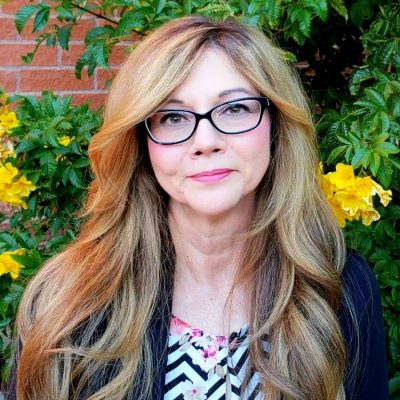6 Nuestra Comunidad – Our Community
Mònica De Soto Vega
I grew up in a predominantly Latinx area of Tucson close to the Pascua Yaqui reservation, yet it wasn’t until college, in a Mexican American Studies (MAS) general education course, that I learned about the Yaqui Nation. Unquestionably, this was one of my favorite courses and had an entire unit dedicated to the tribe’s cultural history. The Yaquis survived horrendous persecution at the hands of the Mexican government. Forced to escape their homeland, the Yaquis migrated to Arizona where they continue to maintain their customs and traditions.
The MAS unit culminated with a visit to Old Pascua Village (OP), the oldest Yaqui settlement in the U.S. There we observed the annual La Danza de Venado, the Deer Dance. (It is important to note that my recollection of this ceremony is that of a visitor and not an expert. I encourage readers to visit the Yaqui Nation website to learn more.) Yaquis are one with the flowers and animals of the desert, and the ceremonial dance demonstrates this deep connection to nature. The sound of cocoon and gourd rattles and chants; the intricate detail of the dancers’ attire and accessories; the masks and deer headdress are elements that pay homage to the deer and the hunt. A unique feature of the ritual is syncretism, which is a blending of pre-Christian customs with newfound Christian beliefs. For example, this ceremony is held during and is closely tied to the Christian Lenten and Easter season.
This sacred tradition is never photographed or filmed; therefore, witnessing the ceremony in person was awe-inspiring. It was a common opinion among my classmates that if not for the course and the field trip to OP, we may not have ever experienced the event that ended up being a pivotal moment for us as a learning community. After the OP visit, open in-class dialogue flourished, and we became more aware and open-minded together. Many revealed, including me, that the course was immensely valuable in helping us develop a deep appreciation for each other and the Mexican American and Yaqui cultures we learned about.
UA is a small piece of the world with faculty, staff, and students who come from around the globe. Our proximity to the border and home to several Indigenous populations make the campus an ideal place to meet people from diverse backgrounds. This has been the case for me, a UA employee who has met people from six continents, many of whom are graduate and undergraduate students. Most of those I come to know are often from out of state or from different countries and I imagine that when first settling into a new and different environment, it can be comforting to find those who see and accept you. I attempt to be that person by reaching out and getting to know those new to campus, especially since I know what it feels like to not have that extended to me — to have me, my home, and my community judged.
One example of this prejudice occurred 25 years ago during a local women’s group meeting. This group was created for women new to Tucson, but locals were invited to participate. During introductions, I learned I was the sole Tucson native. The discussion prompt for that day asked what places within the community were unsafe for women. (Later, we were told that, statistically, women are harmed by someone they know rather than a stranger.) What was hurtful to me was that the areas deemed unsafe to women were those of my childhood home and barrios closely tied to my upbringing. This was troubling, since most of the individuals commenting about unsafe places had earlier communicated that they had just recently moved to Tucson.
I informed the group they were speaking about places from my childhood, where I had only good memories, and I went on to express my strong sense of pride in where I’m from. As one of Tucson’s pioneering families, our lineage spans nine generations and my ancestors are woven into the fabric of Tucson’s history. I expressed to the group they should seek ways to learn about the city’s Indigenous and Mexican cultures and learn what is meaningful to those of us who call Tucson home. What I learned through this experience is understanding and valuing differences is a two-way street. One side must be open to learning about cultures different from their own and seek to find and learn about unique qualities within communities new to them. The other side must be open to teaching others about what they find meaningful and value most about their culture and the community they live in.
Being part of the UA community has equipped you to be a world citizen and lifelong learner and you have perhaps come to know the University’s six core values: integrity, compassion, exploration, adaptation, inclusion, and determination. These values are integral to gaining understanding and finding value in differences. My experience in the MAS course taught me that there is always more to discover about the distinct populations around you. For me, it was learning about an Indigenous tribe. The land acknowledgment I include in my email signature line is recognition of the O’odham and Yaqui people and that their homeland is where I was born and now live and work. Working over 20 years at UA has allowed me to welcome new faculty, staff, and students from out of town and it is truly a pleasure to introduce them to Tucson’s multifaceted community, which includes visits to historical districts and barrios. As you join new communities, branch out to explore beyond gentrified areas into spaces that hold meaning for others. Listen and have empathy for those around you. There is much to learn from one another when we seek to uncover beyond what is comfortable and familiar so that we can learn, come to understand, and find value in differences.


